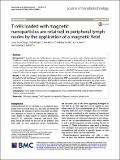Por favor, use este identificador para citar o enlazar a este item:
http://hdl.handle.net/10261/191865COMPARTIR / EXPORTAR:
 SHARE SHARE
 CORE
BASE CORE
BASE
|
|
| Visualizar otros formatos: MARC | Dublin Core | RDF | ORE | MODS | METS | DIDL | DATACITE | |

| Título: | T cells loaded with magnetic nanoparticles are retained in peripheral lymph nodes by the application of a magnetic field. |
Autor: | Sanz-Ortega, Laura; Rojas, José M.; Marcos, Ana CSIC; Portilla, Yadileiny; Stein, Jens V.; Barber, Domingo F. CSIC ORCID | Palabras clave: | Cell-based therapy T cell Magnetic nanoparticle Magnetic retention Lymph node |
Fecha de publicación: | ene-2019 | Editor: | BioMed Central | Citación: | Journal of Nanobiotechnology 17 (1):14 (2019) | Resumen: | BACKGROUND:T lymphocytes are highly dynamic elements of the immune system with a tightly regulated migration. T cell-based transfer therapies are promising therapeutic approaches which in vivo efficacy is often limited by the small proportion of administered cells that reaches the region of interest. Manipulating T cell localisation to improve specific targeting will increase the effectiveness of these therapies. Nanotechnology has been successfully used for localized release of drugs and biomolecules. In particular, magnetic nanoparticles (MNPs) loaded with biomolecules can be specifically targeted to a location by an external magnetic field (EMF). The present work studies whether MNP-loaded T cells could be targeted and retained in vitro and in vivo at a site of interest with an EMF. RESULTS:T cells were unable to internalize the different MNPs used in this study, which remained in close association with the cell membrane. T cells loaded with an appropriate MNP concentration were attracted to an EMF and retained in an in vitro capillary flow-system. MNP-loaded T cells were also magnetically retained in the lymph nodes after adoptive transfer in in vivo models. This enhanced in vivo retention was in part due to the EMF application and to a reduced circulating cell speed within the organ. This combined use of MNPs and EMFs did not alter T cell viability or function. CONCLUSIONS:These studies reveal a promising approach to favour cell retention that could be implemented to improve cell-based therapy. | Versión del editor: | http://dx.doi.org/10.1186/s12951-019-0440-z. | URI: | http://hdl.handle.net/10261/191865 | DOI: | 10.1186/s12951-019-0440-z. | E-ISSN: | 1477-3155 |
| Aparece en las colecciones: | (CNB) Artículos |
Ficheros en este ítem:
| Fichero | Descripción | Tamaño | Formato | |
|---|---|---|---|---|
| 12951_2019_Article_440.pdf | Artículo principal | 7,29 MB | Adobe PDF |  Visualizar/Abrir |
CORE Recommender
PubMed Central
Citations
29
checked on 21-abr-2024
SCOPUSTM
Citations
49
checked on 23-abr-2024
WEB OF SCIENCETM
Citations
44
checked on 26-feb-2024
Page view(s)
213
checked on 24-abr-2024
Download(s)
144
checked on 24-abr-2024
Google ScholarTM
Check
Altmetric
Altmetric
Artículos relacionados:
NOTA: Los ítems de Digital.CSIC están protegidos por copyright, con todos los derechos reservados, a menos que se indique lo contrario.
